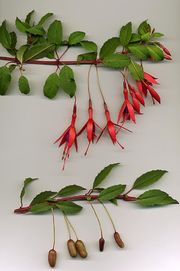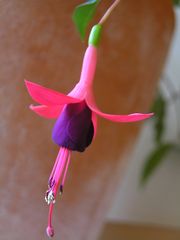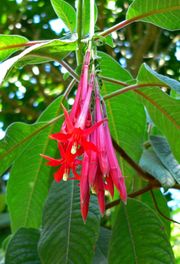Fuchsia
| Fuchsia | |
|---|---|
 |
|
| Fuchsia magellanica shoots with flowers (above) and fruits (below) |
|
| Scientific classification | |
| Kingdom: | Plantae |
| Division: | Magnoliophyta |
| Class: | Magnoliopsida |
| Order: | Myrtales |
| Family: | Onagraceae |
| Genus: | Fuchsia L. [1] |
| Species | |
|
About 100; see text |
|

Fuchsia (pronounced /ˈfjuːʃə/ FEW-shə) is a genus of flowering plants, mostly shrubs, and can grow long shoots, which were identified by Charles Plumier in the late 17th century, and named by Plumier in 1703 after the German botanist Leonhart Fuchs (1501–1566).[2] The English name fuchsia is frequently misspelled fuschia.
Contents |
Description
There are about 100–110 species of Fuchsia. The great majority are native to South America, but with a few occurring north through Central America to Mexico, and also several from New Zealand to Tahiti One species, Fuchsia magellanica, extends as far as the southern tip of South America, occurring on Tierra del Fuego in the cool temperate zone, but the majority are tropical or subtropical. Most fuchsias are shrubs from 0.2–4 m (8 in–13 ft 1 in) tall, but one New Zealand species, Kotukutuku (Fuchsia excorticata), is unusual in the genus in being a tree, growing up to 12–15 metres (39–49 ft) tall.
Fuchsia leaves are opposite or in whorls of 3–5, simple lanceolate and usually have serrated margins (entire in some species), 1–25 cm long, and can be either deciduous or evergreen, depending on the species. The flowers are very decorative, pendulous "eardrop" shape, borne in profusion throughout the summer and autumn, and all year in tropical species. They have four long, slender sepals and four shorter, broader petals; in many species the sepals are bright red and the petals purple (colours that attract the hummingbirds that pollinate them), but the colours can vary from white to dark red, purple-blue, and orange. A few have yellowish tones, and recent hybrids have added the colour white in various combinations. The ovary is inferior and the fruit is a small (5–25 mm) dark reddish green, deep red, or deep purple, edible berry, containing numerous very small seeds. Many people describe the fruit as having a subtle grape flavor spiced with black pepper.
Species
Felix Munz in his The Genus Fuchsia classified the genus into seven sections of 100 species. The majority of species, 94 of them, originate in Central and South America, West Indies, Haiti and Cuba. The other 6 species were found in New Zealand and Tahiti.
The vast majority of garden hybrids have descended from a few parent species.[3]
Section 1: Quelusia
.jpg)
Species in this section have the nectary fused to the base of the hypanthium (tube). The hypanthium is cylindrical and is generally no longer than the sepals. The stamens are long and extend beyond the corolla (petals) (exserted).
- Fuchsia alpestris
- Fuchsia bracelinae
- Fuchsia brevilobis
- Fuchsia campos-portoi
- Fuchsia coccinea
- Fuchsia glazioviana
- Fuchsia hatschbachii
- Fuchsia magellanica
- Fuchsia regia
Section 2: Fuchsia

Sect. Fuchsia (syn. Eufuchsia) is the largest section of fuchsias. Flowers are perfect with convolute petals, erect stamens that may or may not project beyond the corolla; the stamens opposite the petals are shorter. The fruit has many seeds.
- Fuchsia abrupta
- Fuchsia andrei
- Fuchsia asperifolia
- Fuchsia aspaiziu
- Fuchsia asplundii
- Fuchsia austromontana
- Fuchsia ayavacensis
- Fuchsia boliviana
- Fuchsia canescens
- Fuchsia confertifolia
- Fuchsia cordifolia
- Fuchsia corymbiflora
- Fuchsia cuatresasasii
- Fuchsia decussata
- Fuchsia denticulata
- Fuchsia fischeri
- Fuchsia fufuraceae
- Fuchsia gehringeri
- Fuchsia glaberrima
- Fuchsia hartwegii
- Fuchsia hirtella
- Fuchsia hypoleuca
- Fuchsia jahnii
- Fuchsia Lehmanii
- Fuchsia leptopoda
- Fuchsia llewelynii
- Fuchsia loxensis
- Fuchsia macrophylla
- Fuchsia macrostigma
- Fuchsia magdalenae
- Fuchsia matthewsii
- Fuchsia munzii
- Fuchsia osgoodii
- Fuchsia ovalis
- Fuchsia pallescens
- Fuchsia petiolaris
- Fuchsia pilosa
- Fuchsia pltypteala
- Fuchsia polyantha
- Fuchsia pringsheimii
- Fuchsia putamayensis
- Fuchsia rivularis
- Fuchsia sanctae-rosae
- Fuchsia scabriscaula
- Fuchsia sessilifolia
- Fuchsia simplisicaulis
- Fuchsia smithii
- Fuchsia splendens
- Fuchsia storkii
- Fuchsia sylvatica
- Fuchsia tincta
- Fuchsia townsendii
- Fuchsia triphylla
- Fuchsia venusta
- Fuchsia verrucosa
- Fuchsia woytkowskii
Section 2a: Ellobium
This section contains three species.
- Fuchsia decidua
- Fuchsia fulgens
- Fuchsia splendens
Section 3: Kierschlegeria
This section possesses a single species. This species has pedicels which are in the axils and are pendulous. The leaves are sparse and the sepals are reflexed and slightly shorter than the tube.
- Fuchsia lycioides
Section 4: Skinnera
The main characteristics of this section include a floral tube that is swollen above the ovary (future fruit). The sepals curve back on themselves and the petals are small or near absent. Skinnera are primarily from New Zealand, with one species (F. cyrtandroides) from Tahiti.
- Fuchsia colensoi
- Fuchsia cyrtandroides
- Fuchsia excorticata
- Fuchsia perscandens
- Fuchsia procumbens
Section 5: Hemsleyella
The species in this section are characterised by a nectary that is fused with the base of the flower tube with petals that are partly or completely lacking.
|
|
Section 6: Schufia
Plants in this section have flowers that are erect on the plant in a corymb-like panicle.
- Fuchsia arborescens
- Fuchsia paniculata
Section 6a: Jimenezia
- Fuchsia jimenezia
Section 7: Encliandra
Flowers on species in this section have flat petals, short stamens and are reflexed into the tube. Fruits contain few seeds.
|
|
|
|
Cultivation

Fuchsias are popular garden shrubs, and once planted can live for years with a minimal amount of care. The British Fuchsia Society maintain a list of "hardy" fuchsias that have been proven to survive a number of winters throughout Britain and to be back in flower each year by July. Enthusiasts report that hundreds and even thousands of hybrids survive and prosper throughout Britain.
Fuchsias from sections Quelusia (F. magellanica and variants, F. regia, etc.), encliandra (some encliandra hybrids flower continuously), Skinnera (F. excorticata, F. perscandens) and Procumbentes (F. procumbens is suitable as a groundcover) are proven to be hardy in widespread areas of Britain and Ireland. Some temperate species will survive outdoors in the temperate areas, though may not always flower in the average British summer.
Due to a very temperate climate fuchsias grow abundantly in the West Cork region of Ireland and are associated with the area to such an extent that a local branding initiative uses the fuchsia flower as their logo.[4]
Pests and diseases
Fuchsias are eaten by the caterpillars of some Lepidoptera, such as the Elephant Hawk-moth (Deilephila elpenor)) and the Black-lyre Leafroller Moth ("Cnephasia" jactatana).
Pronunciation
While the original pronunciation from the word's German origin is "fook-sya" /ˈfʊksja/, most English speakers tend to say "fyusha" /ˈfjuːʃə/.
History

Leonhart Fuchs was born in 1501. He occupied the chair of Medicine at the Tübingen University from the age of 34 until his death, on 10 May 1566. Besides his medical knowledge, according to his record of activities which was extensive for the time, he studied plants. This was natural, as most of the remedies of the time were herbal and the two subjects were often inseparable.
In the course of his career Fuchs wrote De Historia Stirpium, which was published in 1542. In honour of Fuchs' work the fuchsia received its name shortly before 1703 by Charles Plumier. It was Plumier who compiled his Nova Plantarum Americanum, which was published in Paris in 1703, based on the results of his plant-finding trip to America in search of new genera.
The fuchsia was in England in the 18th century when Plumier took some seeds there after his expedition. The species he took was Fuchsia triphylla flore coccinea where specimens appeared in France. This may account for its reference under the name of "Thiles" in the Journal des Observations Botaniquesin 1725. Thiles was the name by which the plant was known in southern Chile where Plumier discovered it.
Professor Philip Munz, in his A Revision of the Genus Fuchsia, 1793 says, however, that the fuchsia was first introduced into England by a sailor who grew it in a window where it was observed by a nurseryman from Hammersmith, a Mr. Lee, who succeeded in buying it and propagating it for the trade. This was one of the short tubed species such as magellanica or coccinea.

This report is further embellished in various publications where Captain Firth, a sailor, brought the plant back to England from one of his trips to his home in Hammersmith where he gave it to his wife. Later on James Lee of St. Johns Wood, nurseryman and an astute businessman, heard of the plant and purchased it for £80. He then propagated as many as possible and sold them to the trade for prices ranging from £10 to £20 each.
In the Floricultural Cabinet, 1855, there is a report which varies slightly from the above. Here it says that F. coccinea was given to Kew Garden in 1788 by Captain Firth and that Lee acquired it from Kew.
By this time plant-collecting fever had spread and many species of numerous genera were introduced to England, some living plants, others as seed. The following plants were recorded at Kew: F. lycioides, 1796; F. arborescens, 1824; F. microphylla, 1827; F. fulgens, 1830; F. corymbiflora, 1840; and F. apetala, F. decussata, F. dependens and F. serratifolia in 1843 and 1844, the last four species attributable to Messrs. Veitch of Exeter.
With the increasing numbers of differing species in England plant breeders began to immediately develop hybrids to develop more desirable garden plants. The first recorded experiments date to 1825 as F. arborescens Χ F. macrostemma and F. arborescens X F. coccinea where the quality of the resultant plants was unrecorded.
Between 1835 and 1850 there was a tremendous influx to England of both hybrids and varieties, the majority of which have been lost.
In 1848 Monsieur Felix Porcher published the second edition of his book Le Fuchsia son Histoire et sa Culture. This described 520 species. In 1871 in later editions of M. Porchers book reference is made to James Lye who was to become famous as a breeder of fuchsias in England. In 1883 the first book of English fuchsias was published.
Between 1900 and 1914 many of the famous varieties were produced which were grown extensively for Covent Garden market by many growers just outside London. During the period between the world wars, fuchsia-growing slowed as efforts were made toward crop production until after 1949, when plant and hybrid production resumed on a large scale.[3]
References
- ↑ Clive A. Stace (2010). "Fuchsia L. – fuchsias". New Flora of the British Isles (3rd ed.). Cambridge University Press. p. 365. ISBN 978-0-521-70772-5.
- ↑ (1910) The Encyclopædia Britannica: A Dictionary of Arts, Sciences, Literature and General Information, 11th Edition: Volume XI, Franciscans to Gibbons The Encyclopædia Britannica Company: New York, page 272. Retrieved on 2007-09-25.
- ↑ 3.0 3.1 A. G. Puttock (1959). Lovely Fuchsias. London: Gifford.
- ↑ http://www.fuchsiabrands.com/
External links
- Some fuchsia societies
- Other selected fuchsia sites
- Pictures of Fuchsia lycioides and Fuchsia magellanica in Chile.
- Find That Fuchsia
- In Ground Fuchsia Group In Ground Fuchsias in Australia.